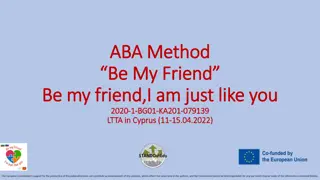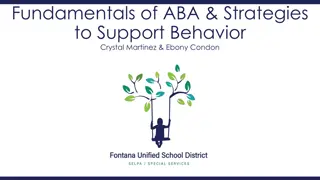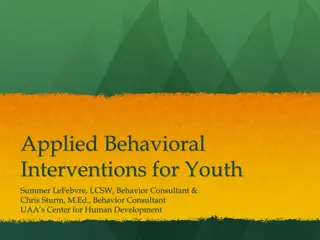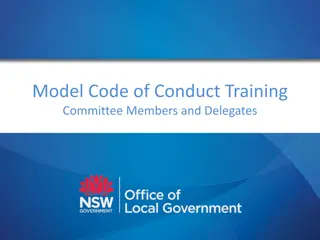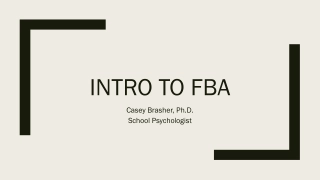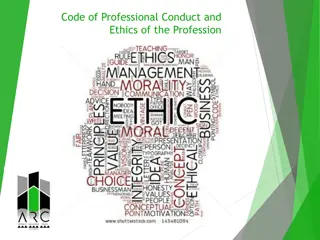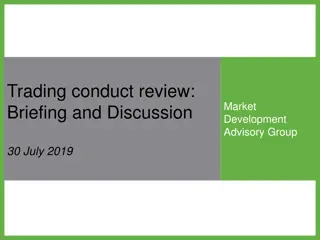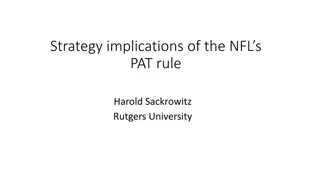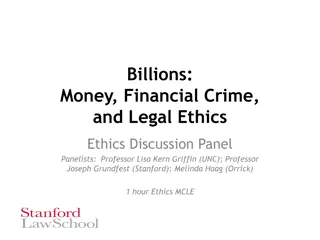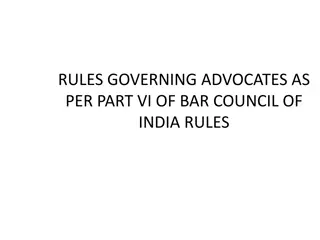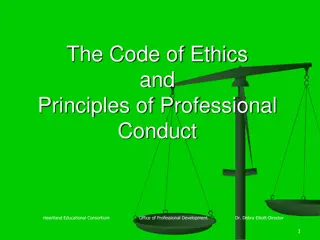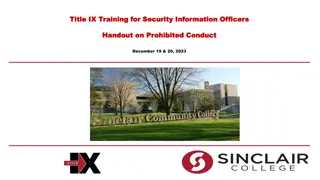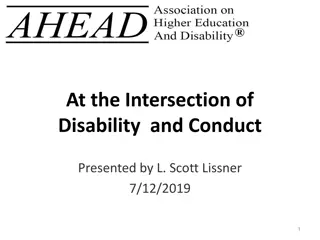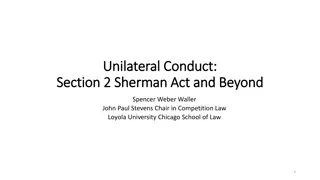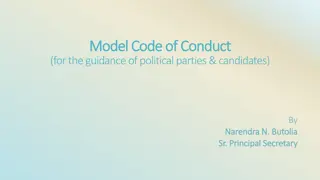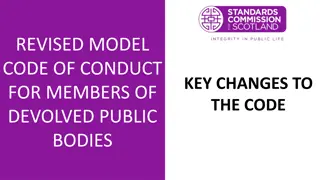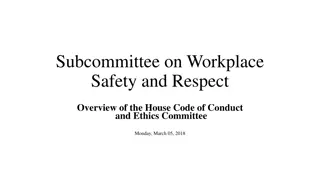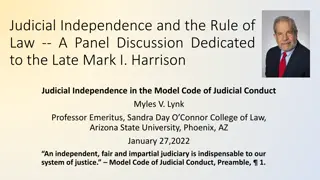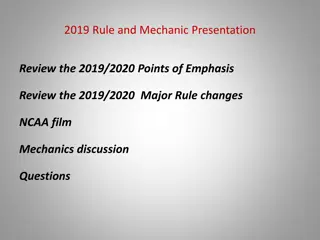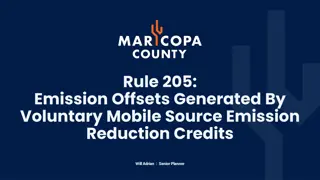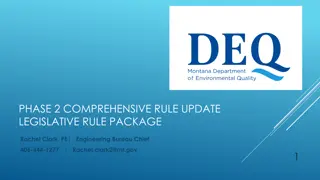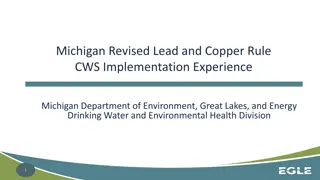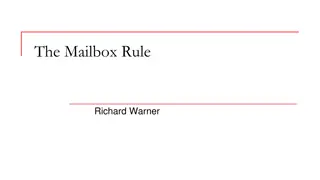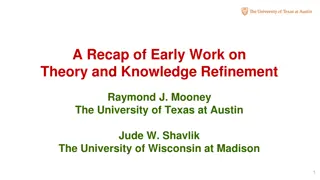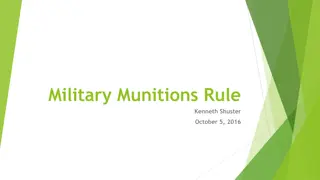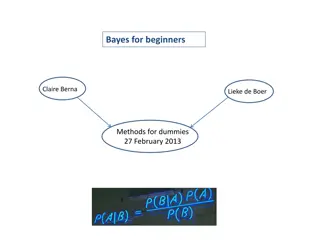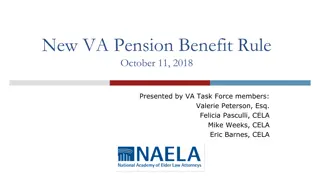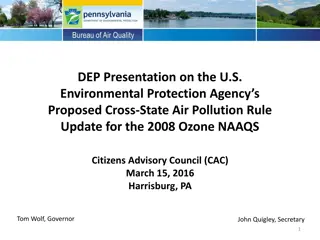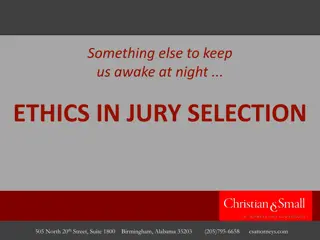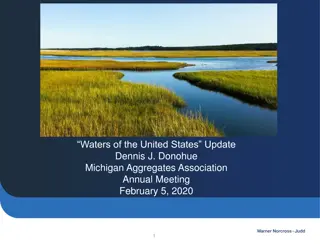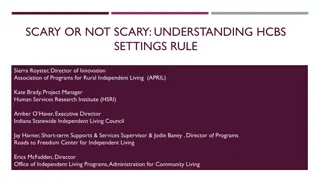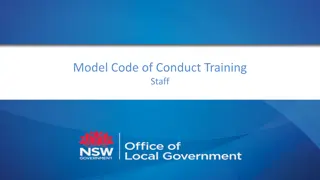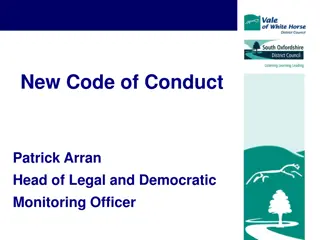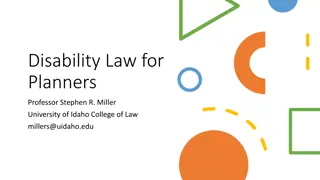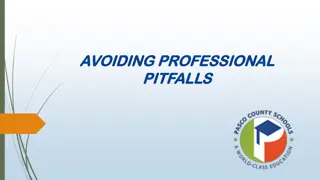Implications of ABA Model Rule 8.4(g) on Professional Conduct
The American Bar Association's Model Rule 8.4(g) addresses professional misconduct in legal practice related to discrimination and harassment based on various factors. The rule has been adopted by some states, sparking discussions on its implications and challenges within the legal community. Explore how Rule 8.4(g) impacts lawyers and the practice of law, with insights from experts and organizations involved in shaping its implementation.
Download Presentation

Please find below an Image/Link to download the presentation.
The content on the website is provided AS IS for your information and personal use only. It may not be sold, licensed, or shared on other websites without obtaining consent from the author. Download presentation by click this link. If you encounter any issues during the download, it is possible that the publisher has removed the file from their server.
E N D
Presentation Transcript
Implications of the American Bar Association Model Rule 8.4G
The ABA adopted Model Rule 8.4(g) in August 2016. The new proposed rule goes into effect only when it is adopted in a state.
The Model Rule has been sent to all 50 states for consideration, and as of October 2020, Vermont and New Mexico have adopted it and Maine and Pennsylvania have adopted a modified version (10/2020.) For resources on 8.4(g) go to the CLS website: https://www.christianlegalsociety.org/aba-model-rule-84g-news
A special thanks to CLS s Center for Religious Freedom and to Reed Smith, Director of Litigation at the Christian Legal Society. Much of the materials I have used were created by or inspired by his work. The Center has been at the forefront of familiarizing attorneys around the country with regard to the Model Rule 8,4(g). CLS Web Page: https://www.christianlegalsociety.org/resource/aba-model-rule-84g-and- states . Ronald Rotunda: Heritage FoundationThe ABA Decision to Control What Lawyers Say: Supporting Diversity But Not Diversity of Thought Thanks also to the ABA webpage concerning Model Rule 8.4(g) 8.4(g) https://www.americanbar.org/news/abanews/publications/youraba/2018/october- 2018/the-crusade-against-model-rule-8-4-g-/ Social Justice https://www.americanbar.org/groups/crsj/publications/chair-column- archive/statement-from-the-officers-of-the-section-of-civil-rights-and-s/
ABA MODEL RULE 8.4(g): -What is it? -Why is it problematic?
New RULE 8.4(G) [It is professional misconduct for a lawyer to:] (g) engage in conduct that the lawyer knows or reasonably should know is harassment or discrimination on the basis of race, sex, religion, national origin, ethnicity, disability, age, sexual orientation, gender identity, marital status or socioeconomic status in conduct related to the practice of law. This paragraph does not limit the ability of a lawyer to accept, decline or withdraw from a representation in accordance with Rule 1.16. This paragraph does not preclude legitimate advice or advocacy consistent with these Rules.
Rule 8.4(g) provides that it is professional misconduct to engage in discrimination or harassment based on race, sex, religion, national origin, ethnicity, disability, age, sexual orientation, gender identity, marital status or socioeconomic status in conduct related to the practice of law.
RATIONAL Discrimination and harassment by lawyers in violation of paragraph (g) undermine confidence in the legal profession and the legal system. Rule 8.4(g) Comment 3
TO CULTIVATE A LEGAL COMMUNITY FREE OF HARASSMENT AND DISCRIMINATION. News headlines reveal bias, harassment, and discrimination are still alive and well in business, government, and the practice of law. The American Bar Association ( ABA ), in developing the Model Rules of Professional Conduct for lawyers, recently amended the rules and provided comments to cultivate a legal community free of harassment and discrimination, where lawyers are consistently ethical and professional in the practice of law. to raise awareness and curb discriminatory and/or harassing conduct by lawyers. ABA s: The Evolution of Model Rule 8.4 (g): Working to Eliminate Bias, Discrimination, and Harassment in the Practice of Law- https://www.americanbar.org/groups/construction_industry/publications/under_construction/2019/spring/model-rule-8-4/
Ronald Rotunda, in critiquing the Model Rule notes: When the ABA proposed this new rule, it did not offer any examples in its report of the failure of the old comment. That is not why it wanted to change this new rule. The reason for the change, the ABA says, is not so modest There is a need for a cultural shift in understanding the inherent integrity of people regardless of their race, color, national origin, religion, age, sex, gender identity, gender expression, sexual orientation, marital status, or disability, to be captured in the rules of professional conduct. Standing Committee on Ethics and Professional Responsibility Draft Proposal to Amend Model Rule 8.4 Dec. 22, 2015 https://www.americanbar.org/content/dam/aba/administrative/professional_responsibility/rule_8_4_language_choice_memo_12_22_20 15.authcheckdam.pdf Rotunda
To Create a Cultural Shift In Understanding So, Professor Rotunda observes: We must change the Model Rules not to protect clients, not to protect the courts and the system of justice, and not to protect the role of lawyers as officers of the court. No, the purpose is much more grandiose: to create a cultural shift.
..there are characteristics of an age such as ours which are the same wherever we happen to be. As we go along, it will become clear how far-reaching are the practical consequences of a proper understanding of these movements of thought. (Introduction to Escape From Reason, Francis A. Schaeffer, Escape From Reason, Introduction) 12
2016 Election: Do Away with Deep Seated Cultural Codes and Religious Beliefs Laws have to be backed up with resources and political will. And deep-seated cultural codes, religious beliefs and structural biases have to be changed. As I have said and as I believe, the advancement of the full participation ( read equality ) of women and girls in every aspect of their societies is the great unfinished business of the 21st century and (equality ) not just for women but for everyone and not just in faraway countries but right here in the United States. Hillary Clinton, April 26, 2015. https://m.hrc.onl/secretary/01-home/05-nov/19-podesta/bg-380x254.jpg
Modern Americans disagree about many things. But about one thing, I think there is almost unanimous consent. That is that we are living in a time of wide spread social confusion and fragmentation. Deep disagreements about a long list of cultural and social matters have multiplied and intensified. When James Davison Hunter wrote his book, The Culture Wars, in I991 few people imagined that we would soon be fighting about whether a man marry another man or whether a man could declare himself to be a woman and require through force of law that his declaration be recognized and even celebrated. Ken Meyers, Friday Feature, 10/2/2020
Liberty The Sweet Mystery Clause The Legal Logic Behind the Unfaltering Commitment of Progressivism To the Equality of Radical Individualism. "At the heart of liberty
At the heart of liberty "is the right to define one's own concept of existence, of meaning, of the universe, and of the mystery of life. Justice Kennedy, Planned Parenthood v. Casey, 1992
THE SOVERIEGN WILL David Bentley Hart described this nihilism in a 2003 First Things article entitled Christ and Nothing. We live in an age, writes Hart, whose chief moral value has been determined by overwhelming consensus to be the absolute liberty of personal volition, the power of each of us to choose what he or she believes, wants, needs, or must possess. The will, we believe, is sovereign and this is the highest good. Society must thus be secured against the intrusions of the good, or of God, so that its citizens may determine their own lives by the choices they make from a universe of morally indifferent but variably desirable ends, unencumbered by any prior obligation or value. Friday Feature: Key Meyers. Oct 2nd, 2020
the manifestation of social justice that has captured the imagination of academia, the media, and the broader culture is best understood as an application of critical theory, a broad area of knowledge that seeks to understand society primarily through the lens of power and emancipation.
WHAT IS CRITICAL THEORY? The Frankfurt School, a group of philosophers and sociologists working in Germany during the 1920s and 1930s, coined the term Critical Theory.1 They sought to extend Marxist analysis beyond economic exploitation to show how domination occurs through the machinery of culture. But their goal was not merely descriptive. They insisted that a truly critical theory should not just seek to explain but to transform society, making it more just, democratic, and equitable. The Journal of Christian Legal Thought, Vol.10, No. 1 (2020) Critical Theory and the Social Justice Movement NEIL SHENVI AND PAT SAWYER
THE FRANKFURT SCHOOL While the work of the Frankfurt School was pioneering, critical theory has expanded dramatically over the last nine decades. In its broadest sense, the term critical theory or critical social theory now encompasses entire disciplines. In the field of jurisprudence, it includes Critical Legal Theory and Critical Race Theory and also encompasses Critical Pedagogy and Queer Theory. Given such a sprawling, amorphous category, trying to answer the question What is critical theory? is challenging. The Journal of Christian Legal Thought, Vol.10, No. 1 (2020) Critical Theory and the Social Justice Movement NEIL SHENVI AND PAT SAWYER
So whats the connection between the Liberty of the Sweet Mystery Passage and Cultural Marxism- or Critical Theory?
Authority Over the Autonomous Self Which Traditional Institutions Perpetuate Violates the Liberty That Is the Very Essence of Being Human Humanity s main problem is not merely economic. It is that societies ideas and institutions prevent us from fufilling the good life. What is the good life? It is not just material provision: having food shelter and clothing. Rather it is being able to be exactly what we want to be to live exactly as we want to live. 22
Liberating humanity from the social Institutions and conditions. Critical Theory is all about liberating humanity from the social Institutions and conditions (like the family and church and business and traditional views and habits and authorities)that prevent the individual from realizing his true self, his true desires and aspirations, and for being anything he wants to be full autonomy Andrew Sandlin 23
Whats the big deal? Whats All This Have to Do With Model Rule 8.4(g)?
The Shift - Old Model Rule 8.4(d) Rule 8.4: It is professional misconduct for a lawyer to: (d) engage in conduct that is prejudicial to the administration of justice.
Old Rule 8.4 | Comment [3] A lawyer who, in the course of representing a client, knowingly manifests by words or conduct, bias or prejudice based upon race, sex, religion, national origin, disability, age, sexual orientation or socioeconomic status, violates paragraph (d) when such actions are prejudicial to the administration of justice. respecting the foregoing factors does not violate paragraph (d). Legitimate advocacy
Old Rule 8.4 | Comment [3] A lawyer who, in the course of representing a client, knowingly manifests by words or conduct, bias or prejudice based upon race, sex, religion, national origin, disability, age, sexual orientation or socioeconomic status, violates paragraph (d) when such actions are prejudicial to the administration of justice. Legitimate advocacy respecting the foregoing factors does not violate paragraph (d). ..
New RULE 8.4(G) [It is professional misconduct for a lawyer to:] engage in conduct that the lawyer knows or reasonably should know is harassment or discrimination on the basis of race, sex, religion, national origin, ethnicity, disability, age, sexual orientation, gender identity, socioeconomic status in conduct related to the practice of law. This paragraph does not limit the ability of a lawyer to accept, decline or withdraw from a representation in accordance with Rule 1.16. This paragraph does not preclude legitimate advice or advocacy consistent with these Rules. marital status or
OPPOSITION INCLUDING THAT FROM THE ABA STANDING COMMITTEE ON PROFESSIONAL DISCIPLINE The Proposal Continues to Suffer from Vagueness That Raises Enforceability and Possible Constitutional Concerns. "The Discipline Committee Supports Retention of the Mens Rea Requirement for Harassment and Discrimination. Categories of Individuals Not Yet Afforded Constitutional Protection [may] Raise Constitutional Concerns. The Proposed Model Rule 8.4(g) and Comment Do Not Adequately Address Other Issues, Including Lawyers Decisions to Decline a Representation.
MAJOR CHANGES Moves from comment to text of the black letter rule Changes Prejudicial to the Administration of Justice to Harmful, Derogatory or Demeaning Verbal or Physical Conduct Changes course of representing a client to related to the practice of law Changes knowingly to knows or reasonably should know Adds 3 new categories to the protected classes
MOVES FROM COMMENT TO TEXT OF THE BLACK LETTER RULE Violations of the rules matter. They are more than Law Day rhetoric. lf lawyers do not follow this proposed rule, they risk discipline (e.g., disbarment or suspension from the practice of law). In addition, courts enforce the rules in the course of litigation (e.g., through sanctions or disqualification) and routinely imply private rights of action from violation of the rules (malpractice and tort suits by non- client third parties).. Rotunda
NEW Rule 8.4 | Comment [3] Discrimination and harassment by lawyers in violation of paragraph (g) undermine confidence in the legal profession and the legal system. Such discrimination includes harmful verbal or physical conduct that manifests bias or prejudice towards others. Harassment includes sexual harassment and derogatory or demeaning verbal or physical conduct. Sexual harassment includes unwelcome sexual advances, requests for sexual favors, and other unwelcome verbal or physical conduct of a sexual nature. The substantive law of antidiscrimination and anti-harassment statutes and case law may guide application of paragraph (g).
NEW Rule 8.4 | Comment [3] Discrimination and harassment by lawyers in violation of paragraph (g) undermine confidence in the legal profession and the legal system. Such discrimination includes harmful verbal or physical conduct that manifests bias or prejudice towards others. Harassment includes sexual harassment and derogatory or demeaning verbal or physical conduct. Sexual harassment includes unwelcome sexual advances, requests for sexual favors, and other unwelcome verbal or physical conduct of a sexual nature. The substantive law of antidiscrimination and anti-harassment statutes and case law may guide application of paragraph (g).
NEW Rule 8.4 | Comment [3] Discrimination and harassment by lawyers in violation of paragraph (g) undermine confidence in the legal profession and the legal system. Such discrimination includes harmful verbal or physical conduct that manifests bias or prejudice towards others. Harassment includes sexual harassment and derogatory or demeaning verbal or physical conduct. Sexual harassment includes unwelcome sexual advances, requests for sexual favors, and other unwelcome verbal or physical conduct of a sexual nature. The substantive law of antidiscrimination and anti-harassment statutes and case law may guide application of paragraph (g).
NEW Rule 8.4 | Comment [3] Discrimination and harassment by lawyers in violation of paragraph (g) undermine confidence in the legal profession and the legal system. Such discrimination includes harmful verbal or physical conduct that manifests bias or prejudice towards others. Harassment includes sexual harassment and derogatory or demeaning verbal or physical conduct. Sexual harassment includes unwelcome sexual advances, requests for sexual favors, and other unwelcome verbal or physical conduct of a sexual nature. The substantive law of antidiscrimination and anti-harassment statutes and case law may guide application of paragraph (g).
Harmful or Derogatory or Demeaning Verbal or Physical Conduct Discrimination includes harmful verbal or physical conduct that manifests bias or prejudice towards others. Harassment includes sexual harassment demeaning verbal or physical conduct. and derogatory or ABA Model Rule 8.4(g) Comment 3
Conduct Related to the Practice of Law Your controversial statement could land you in disciplinary proceedings if made while: Having dinner with your colleagues Serving on the board of a church, religious school Giving a CLE Presentation Participating in a Balanced Panel Serving as a Chancellor of A Diocese
Old categories: race, sex, religion, national origin, disability, age, sexual orientation or socioeconomic status New categories: race, sex, religion, national origin, ethnicity, disability, age, sexual orientation, gender identity, marital status or socioeconomic status
Legitimate Advocacy Rule 8.4(g) does not preclude legitimate advocacy consistent with these Rules * *Plain English Translation: Rule 8.4(g) does not preclude advocacy not precluded by Rule 8.4(g). Disciplinary panels must make implicit distinctions between legitimate and illegitimate advocacy.
Why 8.4(g) is dangerous. Speech code for lawyers Safeguards exacerbate the problems Viewpoint discriminatory Targeted at religiously motivated conduct Unclear effect on accepting or declining representation
8.4(g): A Speech Code for Lawyers Many [lawyers], rather than undertake the considerable burden (and sometimes risk) of vindicating their rights through case-by-case litigation, will choose simply to abstain from protected speech. Virginia v. Hicks, 539 U.S. 113, 119 (2003)
Herbert Marcuse- Objective Tolerance Herbert Marcuse THIS essay examines the idea of tolerance in our advanced industrial society. The conclusion reached is that the realization of the objective of tolerance would call for intolerance toward prevailing policies, attitudes, opinions, and the extension of tolerance to policies, attitudes, and opinions which are outlawed or suppressed.In other words, today tolerance appears again as what it was in its origins, at the beginning of the modern period--a partisan goal, a subversive liberating notion and practice. Conversely, what is proclaimed and practiced as tolerance today, is in many of its most effective manifestations serving the cause of oppression. https://www.marcuse.org/herbert/pubs/60spubs/65repressivet olerance.htm 42
Nat'l Ass'n for Advancement of Colored People v. Button, 371 U.S. 415, 438-39 (1963). Court precedents have long protected the First Amendment rights of professionals and have applied strict scrutiny to content-based laws that regulate the noncommercial speech of lawyers. The landmark civil rights case involving lawyers freedom of speech, the Court ruled that a State may not, under the guise of prohibiting professional misconduct, ignore constitutional rights, explaining: Broad prophylactic rules in the area of free expression are suspect. Precision of regulation must be the touchstone in an area so closely touching our most precious freedoms.
Model Rule 8.4(g) may be unconstitutional under two recent Supreme Court decisions: August 2016, National Institute of Family and Life Advocates ( NIFLA ) v. Becerra, 138 S. Ct. 2361 (2018): state restrictions on professional speech are presumptively unconstitutional and subject to strict scrutiny. Under the NIFLA analysis, Proposed Rule 8.4(g) is a content- based speech restriction. As the Court explained, [c]ontent- based regulations target speech based on its communicative content. [S]uch laws are presumptively unconstitutional and may be justified only if the government proves that they are narrowly tailored to serve compelling state interests. As the Court observed, [t]his stringent standard reflects the fundamental principle that governments have no power to restrict expression because of its message, its ideas, its subject matter, or its content.
Matal v. Tam, 137 S. Ct. 1744 (2017), Viewpoint-based restriction on lawyers speech that cannot survive the strict scrutiny triggered by viewpoint discrimination. Within that category, an applicant may register a positive or benign mark but not a derogatory one. The law thus reflects the Government's disapproval of a subset of messages it finds offensive. This is the essence of viewpoint discrimination. A unanimous Court held that a federal statute was facially unconstitutional because it allowed government officials to penalize disparaging speech.
Discrimination includes verbal or physical conduct that manifests bias. The First Amendment applies to speech. The ABA tries to get around that by labeling speech as verbal conduct, but verbal conduct is an oxymoron. Rule 8.4(g) prohibits mere speech divorced from discriminatory action.
8.4(g) in plain language Attorneys will be disciplined for negligently or intentionally1 making an offensive statement2 within the prescribed categories of Rule 8.4(g) around anyone who knows they are a lawyer.3 1 Verbal conduct that a lawyer knows or reasonably should know 2 Harassment includes derogatory or demeaning verbal or physical conduct 3 Conduct related to the practice of law includes business or social activities in connection with the practice of law.
Rule 8.4(g) is not generally applicable Rule 8.4(g) does not target all offensive statements, but only statements that would be considered based on one of eleven enumerated classes: race, sex, religion, national origin, ethnicity, disability, age, sexual orientation, gender identity, marital status or socioeconomic status.
Rule 8.4(g) could be applied selectively to punish religious values Attorneys could be subject to discipline for volunteer legal work on boards of their churches, religious schools and colleges, or other religious ministries. Attorneys membership in religious organizations that choose their members or leaders based on religious beliefs may be subject to discipline as religious discrimination.
Chilled Speech - Intimidation When is Exclusion Inclusion ?


